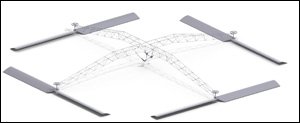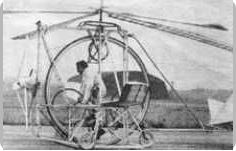- Joined
- 9 October 2009
- Messages
- 21,973
- Reaction score
- 13,628
Clark School Press Release Story
Clark School Team to Test Human-Powered Helicopter
MEDIA ADVISORY May 4, 2011
CONTACT:
Melissa Corley
301 405 6501
mcorley@umd.edu
For More Information:
E-Mail our media staff
or call 301.405.6501
WHAT: In a step toward winning the Sikorsky Prize, a team of A. James Clark School of Engineering students will attempt for the first time to test-fly their human-powered helicopter, called Gamera. Gamera has a rotor at each of the four ends of its X-shaped frame, with the pilot’s module suspended at the middle. Each crossbar of the frame is 60 feet long, and each rotor is 42 feet in diameter. Through the use of balsa, foam, mylar, carbon fiber and other lightweight materials, the entire vehicle weighs only 210 pounds, including the student pilot. All power comes from a combination of hand and foot pedaling. If Gamera makes it off the ground, the team has the potential to capture a world record for human-powered helicopter flight with a female pilot on board.
WHO: A team of more than 50 graduate and undergraduate students led by faculty advisors V.T. Nagaraj, Inderjit Chopra and Darryll Pines (dean of the Clark School). The pilot for the tests is University of Maryland life sciences graduate student Judy Wexler. The Alfred Gessow Rotorcraft Center in the Clark School is one of the nation’s top rotorcraft research institutions.
WHEN: Reporters and photographers are invited to watch the team test the vehicle between 9 a.m. and 12 p.m. on Wednesday, May 11.
WHERE: Comcast Center Auxiliary Gym, University of Maryland, College Park, MD 20742
Directions to Parking (CALL AHEAD for parking information)
WHY: The team has been working for two years to compete for the Sikorsky Prize, run by the American Helicopter Society (AHS). The Clark School team is the only team currently sanctioned by the AHS for making an official attempt. No team has succeeded since the prize was first offered in 1980.
http://www.eng.umd.edu/html/media/release.php?id=104
http://www.youtube.com/watch?v=uT4y4xb2UYI&feature=player_embedded
[PHOTO CREDIT: A.J Clark School of Engineering]
Clark School Team to Test Human-Powered Helicopter
MEDIA ADVISORY May 4, 2011
CONTACT:
Melissa Corley
301 405 6501
mcorley@umd.edu
For More Information:
E-Mail our media staff
or call 301.405.6501
WHAT: In a step toward winning the Sikorsky Prize, a team of A. James Clark School of Engineering students will attempt for the first time to test-fly their human-powered helicopter, called Gamera. Gamera has a rotor at each of the four ends of its X-shaped frame, with the pilot’s module suspended at the middle. Each crossbar of the frame is 60 feet long, and each rotor is 42 feet in diameter. Through the use of balsa, foam, mylar, carbon fiber and other lightweight materials, the entire vehicle weighs only 210 pounds, including the student pilot. All power comes from a combination of hand and foot pedaling. If Gamera makes it off the ground, the team has the potential to capture a world record for human-powered helicopter flight with a female pilot on board.
WHO: A team of more than 50 graduate and undergraduate students led by faculty advisors V.T. Nagaraj, Inderjit Chopra and Darryll Pines (dean of the Clark School). The pilot for the tests is University of Maryland life sciences graduate student Judy Wexler. The Alfred Gessow Rotorcraft Center in the Clark School is one of the nation’s top rotorcraft research institutions.
WHEN: Reporters and photographers are invited to watch the team test the vehicle between 9 a.m. and 12 p.m. on Wednesday, May 11.
WHERE: Comcast Center Auxiliary Gym, University of Maryland, College Park, MD 20742
Directions to Parking (CALL AHEAD for parking information)
WHY: The team has been working for two years to compete for the Sikorsky Prize, run by the American Helicopter Society (AHS). The Clark School team is the only team currently sanctioned by the AHS for making an official attempt. No team has succeeded since the prize was first offered in 1980.
http://www.eng.umd.edu/html/media/release.php?id=104
http://www.youtube.com/watch?v=uT4y4xb2UYI&feature=player_embedded
[PHOTO CREDIT: A.J Clark School of Engineering]


